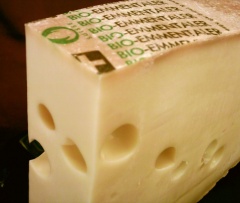Cheese
| Infobox on Cheese | |
|---|---|
| Example of Cheese |  |
| Facts | |
| Origin |
|
| Stowage factor (in m3/t) |
|
| Humidity / moisture | Cheese requires particular temperature, humidity/moisture and ventilation conditions.
|
| Ventilation | Recommended ventilation conditions: circulating air, 15 - 20 circulations/hour; fresh air where required. Inadequately ventilated cheese very rapidly succumbs to the risk of mold growth. In addition, drafts may cause losses in quality. |
| Risk factors | Cheese is sensitive to pressure and impact loads. Improper handling or stowage may result in damage. |
Cheese
Description
Applications
Cheese consists of proteins and fat from milk, usually the milk of cows, buffalo, goats, or sheep. It is produced by coagulation of the milk protein casein. Typically, the milk is acidified and addition of the enzyme rennet causes coagulation. The solids are separated and pressed into final form. Some cheeses have moulds on the rind or throughout. Most cheeses melt at cooking temperature. Hundreds of types of cheese are produced. Their styles, textures and flavors depend on the origin of the milk (including the animal's diet), whether they have been pasteurized, the butterfat content, the bacteria and mould, the processing, and aging. Herbs, spices, or wood smoke may be used as flavoring agents. The yellow to red color of many cheeses is from adding annatto.
For a few cheeses, the milk is curdled by adding acids such as vinegar or lemon juice. Most cheeses are acidified to a lesser degree by bacteria, which turn milk sugars into lactic acid, then the addition of rennet completes the curdling. Vegetarian alternatives to rennet are available; most are produced by fermentation of the fungus Mucor miehei, but others have been extracted from various species of the Cynara thistle family. Cheese is valued for its portability, long life, and high content of fat, protein, calcium, and phosphorus. Cheese is more compact and has a longer shelf life than milk. Cheesemakers near a dairy region may benefit from fresher, lower-priced milk, and lower shipping costs. The long storage life of some cheese, especially if it is encased in a protective rind, allows selling when markets are favorable.
Cheese must be carried in well ventilated spaces, and on longer tropical voyages, in cool storage. Should not be loaded in too fresh or too old a state. Inadequate ventilation will lead to mould formation. Ventilation must be controlled as draughts can also prove damaging. Over-stow by heavy goods may lead to pressure damage, causing spoilage. Temperatures of over 12°C for an extended period will cause most types of cheese to become over-ripe, with risk of complete spoilage. Cheeses vary as to their sensitivity to warmth. Some types when subjected to heat may double or treble their volume, burst their packing and decompose. At temperatures below 0°C cheese will dry out and harden. Subject to loss in weight, especially if improperly stored over a long period. Depending on type, the loss may be as much as 5%. Cheese is very sensitive to odours and should be stored or stowed away from odorous goods. Any break in the packing may cause mould growth or allow the cheese to dry and crack. Mould found on some cheese may be superficial only and can often be wiped off and will not recur under proper stowage conditions. Internally the cheese should be sound and in a perfectly edible condition. Soft cheese should not be kept for over ten days. Other types of cheese may be kept for months at temperatures of 1°C / -4°C.
Temperature
If cheese is stored at excessively cold temperatures, its quality is degraded by drying-out, hardening, loss of aroma (ripening halts) and spoilage. Excessively high temperatures trigger fermentation processes, which may cause the cheese to expand in volume and decompose. Acceptance of a consignment of prechilled cheese must therefore be effected quickly, as there is a risk of the cheese becoming overripe or melting if it becomes warm. Temperature variations may cause the cheese to become crumbly.
Humidity / Moisture
Water content is very heavily dependent on variety. In general, it may be assumed that the harder the cheese, the less water it contains. The cartons must be protected from all forms of moisture (seawater, rain and condensation water) and from excessive humidity levels. Typical patterns of moisture damage to a cargo are as follows:
- loose, mildewed, unattractive labels
- mold on and in cartons
- crushed cartons, due to moisture penetration, leakage, total loss
Ventilation
Risk factors
- Odor
- Contamination
- Mechanical influences
- Toxicity / Hazards to health
- Shrinkage / Shortage
- Insect infestation / Diseases
Note:(Source including Transport Information Service of the GDV)











